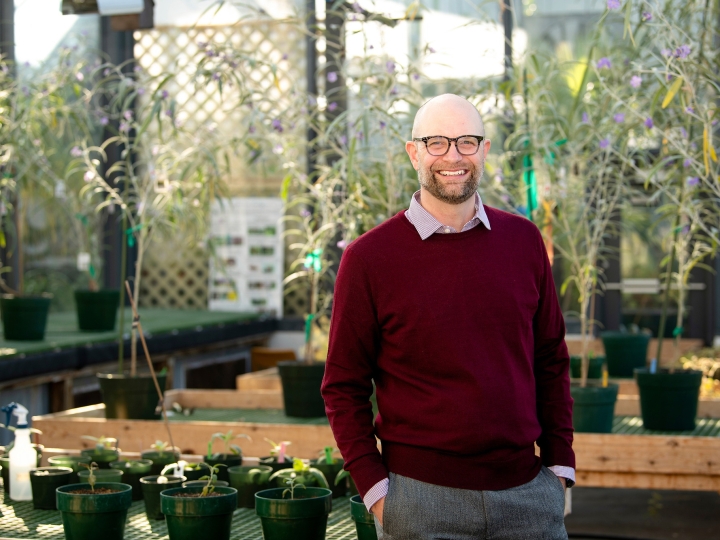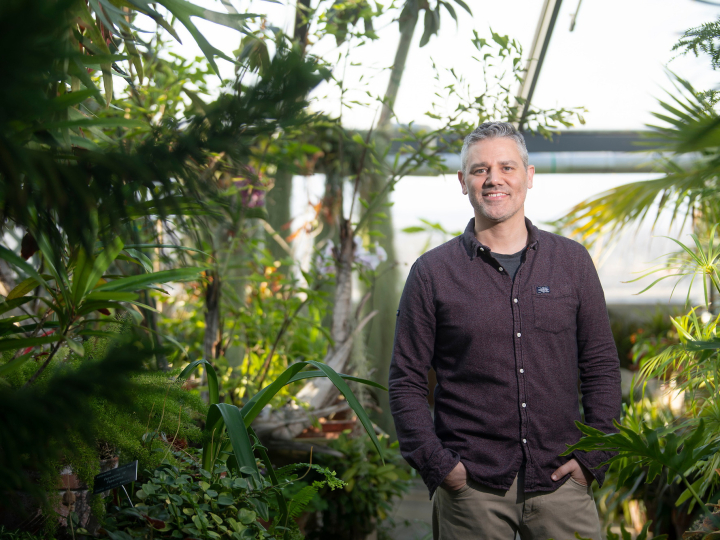Bucknell Student Guides Enhance Museum Experience for Visitors
February 1, 2018
Thought-provoking exhibitions at the Samek Art Museum challenge, thrill and inspire visitors every day. Patrons can engage even more deeply with the works on display thanks to a team of student guides, who are trained to welcome the public, answer questions and spark conversations. Clad in custom-designed T-shirts and brimming with enthusiasm, these roaming docents enhance the visitor experience and reinforce the museum's student-centric mission.
It's a much different vibe from a few years ago, when the Samek's student workers were "gallery guards" who did homework on laptops while keeping an eye on the art. The evolution from guards to guides is part of a move in recent years to create a more valuable experience for patrons — and for student employees, said Director Richard Rinehart, who spearheaded the transition in 2013.
Find Your Path
"A college museum is different than a municipal museum," he said. "This is a teaching institution. So we wanted to make this a true educational experience for our guests and student workers alike."
Gallery guides share a love of art and desire to build skills like researching and presenting information. Only one of the seven current guides majors in studio art or art history — an advantage for the Samek, said Rinehart, who noted their varied backgrounds reflect the academic diversity of Bucknell and make the students relatable to visitors.
"It's different from my classwork, and it's a great way to get exposed to lots of ideas," said Leslie Markevitch '18, anthropology and English-creative writing. "I like interacting with community members and explaining concepts, which can be a challenge because art is open to interpretation. Learning to read people is an important skill I've gained."
Guides receive training in public speaking and learn how to talk about art in a jargon-free way. Before each new exhibition, a curator, usually Rinehart, shares the history, context and backstories they'll need to answer questions or start conversations with visitors of all ages and backgrounds. The guides also complete cultural sensitivity training so they are prepared to discuss challenging art themes in an appropriate way. Guides are on duty during all public hours at the Samek's main gallery on the third floor of the Elaine Langone Center as well as its Downtown Gallery location at 416 Market St.
"The way you approach talking about art can change based on the audience," explained Emily Izer, the Samek's public programs & outreach manager. "We want to teach them how to transfer that power of individual connection to their resumes — these are excellent skills for the job market."
Venturing into Video
As the gallery guide program has grown, so have its ambitions. Last semester, the guides embarked on a new challenge to broaden the Samek's audience — a video tour of some of the museum's most prized pieces. At any given time, the Samek can display only about 1 percent of its 6,000-piece collection in its galleries.
With Izer's guidance, each student chose a piece to research and wrote a script for a five- to seven-minute presentation. After receiving training in video production and editing from Bucknell's Library & Information Technology staff, the team got to work. The resulting video of nine artifacts, which include paintings by Rembrandt, Dalí and Kandinsky, is available to view online and in the Samek Gallery lobby, and the guides have already begun work on a second video tour.
To prepare the students for the video project, Izer took the group on a field trip to the Metropolitan Museum of Art in New York, where they participated in a hands-on training program called Museum Hack.
"It was really fun — a tour guide taught us how to be tour guides," said Skye Romero '21. "We focused on how to be engaging and ask leading questions. We practiced research and presenting, and then got feedback on our work. Having fun facts to keep audiences interested is the key."
Romero, an environmental engineering major, said she was drawn to the position as a way to stay active in the arts, which she enjoyed in high school. The skills she is learning as a gallery guide already benefit her daily life, she added.
"This experience is definitely making me better at approaching people and answering their questions," she said. "It's strengthening my interpersonal skills, and that's something I can use everywhere."
The gallery guides recently undertook another new challenge: organizing an exhibition, which they planned in conjunction with members of the Lewisburg community. Advised by Rinehart, team members wrote a proposal for the show, created a theme and are gathering artifacts, which they'll install in the Downtown Gallery late this semester for summer display.
But ultimately, the program's value will always be rooted in the guides' one-to-one encounters with visitors, said Rinehart, who frequently hears guest feedback praising the students' work. "Those personal connections make the experience of the art more special to our visitors. People are used to sterile, quiet museums. What we have is fresh, interesting and welcoming, and that makes a great impression."

